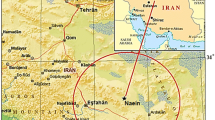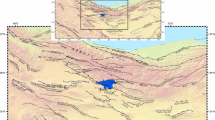Abstract
Probabilistic seismic hazard analysis (PSHA) generally requires the identification of line sources (active faults) and area sources where seismicity parameters must be determined. It is not easy to identify seismic sources and to estimate seismicity parameters for sources in the intraplate region. We perform an alternative PSHA with a synthetic earthquake catalog, which does not require the delineation of seismic sources. A synthetic catalog of the Korean Peninsula for 500,000 years is constructed by simulating earthquakes using the Monte Carlo method in such a way that an earthquake is randomly selected from the observed earthquake catalog, its epicenter is perturbed by a normally distributed random number, and a magnitude is assigned to the simulated event with a random value generated based on the Gutenberg-Richter magnitude-frequency relation with specified minimum and maximum magnitudes. The seismicity of the Korean Peninsula is thoroughly investigated for estimation of parameters required for synthesizing the catalog. The SMSIM computer program is used to simulate ground motions at sites instead of estimating the ground motion prediction equation. Two sites are chosen for PSHA; the one is the Seoul City Hall site (Seoul site), a densely populated metropolitan site, and the other is the Gyeongju City Hall site (Gyeongju site) close to the epicenter of the M L 5.8 earthquake on 12 September 2016. Seismic hazard curve, uniform hazard spectra (UHSs), and deaggregation of hazard for two sites are presented. The mean return periods for 0.1, 0.2, and 0.3 g at the Seoul site appears to be 1640, 6170, and 17650 years, respectively while those at the Gyeongju site appears to be 327, 1197, and 3548 years, respectively. The mean return periods for the Seoul site are around five times longer than those for the Gyeongju site, and this fact implies that the seismic hazard level of the Gyeongju site is considerably higher than that of the Seoul site. UHSs for 10% and 2% probabilities of exceedance over 50 years are constructed at both sites. The spectra show peak amplifications around the 0.05-s period.
Similar content being viewed by others
References
Baker, J.W., 2008, An introduction to probabilistic seismic hazard (PSHA). https://web.stanford.edu/~bakerjw/Publications/Baker_(2008)_ Intro_to_PSHA.
Bazzurro, P. and Cornell, C.A. 1999, Disaggregation of seismic hazard. Bulletin of the Seismological Society of America, 89, 510–520.
Boore, D.M., 1983, Stochastic simulation of high-frequency ground motions based on seismological models of the radiated spectra. Bulletin of the Seismological Society of America, 73, 1865–1894.
Boore, D.M., 2005, SMSIM–Fortran programs for simulating ground motions from earthquakes: Version 2.3–A Revision of OFR 96- 80-A. U.S. Geological Survey, Menlo Park, 55 p.
Boore, D.M. and Joyner, W.B., 1997, Site amplification for generic rock sites. Bulletin of the Seismological Society of America, 87, 327–341.
Cornell, C.A., 1968, Engineering seismic risk analysis. Bulletin of the Seismological Society of America, 58, 1583–1606.
Danciu, L., Pagani, M., Monelli, D., and Wiemer, S., 2010, GEM1 Hazard: Overview of PSHA software. Global Earthquake Model Technical Report 2010-2, 41 p.
Ebel, J.E. and Kafka, A.L., 1999, A Monte Carlo approach to seismic hazard analysis. Bulletin of the Seismological Society of America, 89, 854–866.
Frankel, A., 1995, Mapping seismic hazard in the central and eastern United States. Seismological Research Letters, 66, 8–21.
Geological Society of Korea, 2015, Investigation and research of maximum earthquake for nuclear power plant sites (I). Technical Report to Korea Hydro & Nuclear Power Co., Seoul, 427 p.
Gupta, I.D., 2007, Probabilistic seismic hazard analysis method for mapping of spectral amplitudes and other design-specific quantities to estimate the earthquake effects on man-made structures. Indian Society of Earthquake Technology Journal of Earthquake Technology, 44, 127–167.
Han, S. and Choi, Y., 2008, Seismic hazard analysis in low and moderate seismic region–Korean peninsula. Structural Safety, 30, 543–558.
Jo, N.D. and Baag, C.E., 2003, Estimation of spectrum decay parameter ? and stochastic prediction of strong ground motions in southeastern Korea. Earthquake Engineering Society of Korea Journal of Earthquake Engineering, 7, 59–70.
Kim, S.K., 2007, Seismic wave attenuation in the southern Korean Peninsula: Comparison by the applied method and used data. Journal of Geological Society of Korea, 43, 207–217.
Kim, S.K. and Kim, B.C., 2008, The seismic source parameters for earthquakes occurring in the Korean Peninsula. Journal of Korean Earth Science Society, 29, 117–127.
Kim, S.K., Kim, S.K., and Chi, H.C, 2002, Attenuation of peak spectral amplitude of acceleration in the southern Korean Peninsula. Journal of Korean Earth Science Society, 38, 237–250.
McGuire, R.K., 1976, A Fortran computer program for seismic risk analysis. U.S. Geological Survey, Open File Report 76-67, 84 p.
Musson, R.M.W., 1999, Determination of design earthquakes in seis-mic hazard analysis through Monte Carlo simulation. Journal of Earthquake Engineering, 3, 463–474.
Musson, R.M.W., 2000, The use of Monte Carlo simulations for seismic hazard assessment in the U.K. Annali Geofisica, 43, 1–9.
Page, R., 1968, Aftershocks and microaftershocks of the Great Alaska earthquake of 1964. Bulletin of the Seismological Society of America, 58, 1131–1168.
Rhee, H.M., Seo, J.M., Sheen, D.H., and Choi, I.K., 2012, Probabilistic seismic hazard analysis on metropolitan cities and counties in Korea. Journal of the Geological Society of Korea, 48, 259–273.
Rhee, H.M., Kim, M.K., Sheen, D.H., and Choi, I.K., 2013, Analysis of uniform hazard spectra for metropolises in the Korean Peninsula. Earthquake Engineering Society of Korea Journal of Earthquake Engineering, 17, 71–77.
Stepp, J.C., 1972, Analysis of completeness of the earthquake sample in the Puget Sound area and its effect on statistical estimates of earthquake hazard. Proceedings of the International Conference on Microzonation, Seattle, Oct. 30–Nov. 3, v. 2, p. 897–909.
U.S. Nuclear Regulatory Commission, 2014, Regulatory Guide 1.60, “Design response spectra for seismic design of nuclear power plants”, Washington, DC, 13 p.
Author information
Authors and Affiliations
Corresponding author
Rights and permissions
About this article
Cite this article
Kim, S.K., Lee, J.M. Probabilistic seismic hazard analysis using a synthetic earthquake catalog: comparison of the Gyeongju City Hall site with the Seoul City Hall site in Korea. Geosci J 21, 523–533 (2017). https://doi.org/10.1007/s12303-017-0020-x
Received:
Accepted:
Published:
Issue Date:
DOI: https://doi.org/10.1007/s12303-017-0020-x




